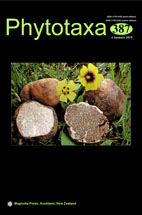Abstract
A new filamentous cyanobacterium, Potamosiphon australiensis gen. et sp. nov., was isolated from a small coastal stream in subtropical north-eastern Australia, and characterised using combined morphological and phylogenetic attributes. It was found growing on the benthos of Fat Hen Creek amongst cobbles, gravel and large woody debris, mostly as single straight or variously flexuous filaments amongst other algae, but occasionally formed loose aggregations amongst littoral vegetation. Morphologically, Potamosiphon is most similar to members of the genus Lyngbya. Filaments were isopolar, cylindrical, not or slightly constricted at the cross walls. Vegetative cells were discoid, broader than long with finely granular contents, aerotopes were not present. Apical cells were rounded, without calyptra or a thickened outer cell wall. Reproduction occurred via motile hormogonia, which formed often in series, after the occurrence of necridic cells. Trichome fragmentation also occurred following a diagonal division. Following this division trichomes often continued to grow past each other within a common sheath. Thylakoids were irregularly arranged throughout the whole cell volume. Phylogenetic analyses using partial 16S rRNA sequences obtained from three strains of P. australiensis showed that it formed a well supported monophyletic clade, sharing less than 94% nucleotide similarity with other cyanobacterial sequences, including putatively related taxa within the Oscillatoriaceae. It also formed a novel clade in the nifH phylogeny, which was associated with the genus Microseira G.B. McGregor & Sendall.

